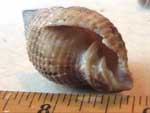




 This particular shell (the larger of the two) appears it may be classed among Pectens and Scallops.
This particular shell (the larger of the two) appears it may be classed among Pectens and Scallops.A shell, quite similar in coloration and shape (Ornate Scallop Chlamys ornatus) is located on page 44, of The Shell Book, commonly located in Southeast Florida and West Indies, as well as slight variation on the shell's hinge (the West Indies species being protruded on the right side and flat on the left), it is unlikely this is the same species featured in my shell book. However it is likely that it is a closely related species.
The smaller shell in the photo (above), seems to have an identical shape with the larger shell, but lacks the speckled colors, it is a solid wine color.
The identification of the specific species of either shell featured above, would be appreciated.
Your scallop shells are Atlantic calico scallops (Argopecten gibbus); up to 3 inches; it's an ocean species and has lots of color combinations. NC also has Atlantic bay scallops which are usually gray or brown and live in the sounds and estuaries.
Terri K. Hathaway
Marine Education Specialist
North Carolina Sea Grant
http://www.ncseagrant.org/
Atlantic calico scallop Argopecten gibbus (Linnaeus)
Description: (3 inches) Similar in shape and sculpturing to the Atlantic Bay Scallop. Both valves cupped. Hinge line with ears. About 20 radial ribs sometimes roughened by growth lines.
Color: Exterior of upper (left) valve dark yellow or pink with striking combinations of red in stripes or blotches. Lower (right) valve whitish with small reddish or purple spots. White interior, often with brown patches on ears and top edge.
Habitat: Lives only in ocean, east of Cape Lookout and southwest of Beaufort Inlet in 100-foot depths. Commonly found on sound and ocean beaches.
Range: Delaware to Brazil.
Notes: It is occasionally fished commercially and popular among tourists.
Source: Seashells of North Carolina, North Carolina Sea Grant College Program














No comments:
Post a Comment